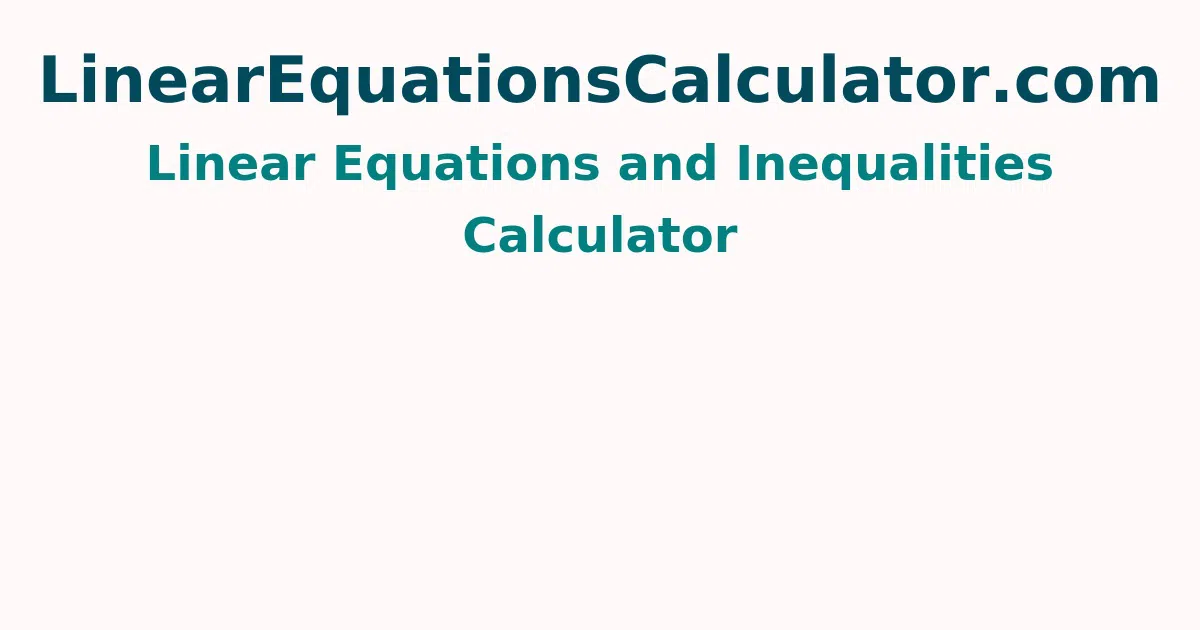Linear Equations and Inequalities Calculator
LinearEquationCalcutor’s online Linear Equations and Inequalities Calculator aids kids and teachers to solve linear inequality problems. Enter given linear equation with inequalities as input in the named box and press the calculate button to generate output within a fraction of seconds.
What is Meant by Linear Equations and Inequalities?
Equations in which the unknown only appears to the first power are called linear equations. The general form of a linear equation in one variable is ax + b = 0, where x is the variable.
A linear inequality resembles an equation by replacing the equal sign with an inequality symbol. Generally, a range of values, rather than one specific value will be the solution to a linear inequality. Some of the examples of Linear Inequation are listed below.
- x < 7
- 5 - y ≥ 30
- x + 5 > 20
- Q ≠ 50
Steps for Linear Inequalities Graphing
The linear inequality graph intersects the coordinate plane into two parts by a borderline. In order to plot the graph of an inequality, we have to follow some basic steps:
- Firstly, check if the given linear inequality equation is arranged properly or not.
- If not rearrange the equation, where the variable will be on the left side and the rest of the expression on the right side of the inequality symbol
- In this step, put the x values in the equation and plot the graph.
- Retain to draw a solid line for y≤ or y≥ and a dashed line for y< or y>.
- Finally, shade the line as per inequalities, like above the line for a “greater than” (y> or y≥) and below the line for a “less than” (y< or y≤).
Steps for Solving One Variable Linear Equations and Inequations
To solve the linear equation or inequality having only one variable, the steps provided below are followed to balance the equation:
- Firstly, add or subtract like terms
- Isolate the variable
- Reverse or eliminate the terms
- Check the answer.
Example:
Find inequality for 6x + 4 > 28
Solution:
Put the variable on the LHS and reverse all the other terms or the coefficient of x to the RHS.
6x > 28 - 4
6x > 24
⇒ x > 4
Hence, the value of x is greater than 4.
Go through all the topics of linear equations from our reliable website ie., Linearequationscalculator.com, and find free online calculators related to linear equations and inequalities concepts.
FAQs on Online Linear Inequalities Calculator with Steps
1. What is inequality in maths?
If two mathematical expressions contain symbols like ‘<’(less than), ‘>’ (greater than), ‘≤’(less than or equal to) or ‘≥’ (greater than or equal to), they are called inequalities.
2. Which method is best for solving linear inequalities of two variables?
For solving linear inequalities of two variables the best approach is the graphical method.
3. What are the symbols that represent inequalities in linear equations?
In linear inequalities, the symbols that are used to represent are
- < (less than)
- > (greater than)
- ≤ (less than or equal to)
- ≥ (greater than or equal to)
- ≠ (not equal to)
4. How to solve the system of linear inequality easily?
Make use of the Linear Equations and Inequalities Calculator and solve the linear inequality calculations easily just by entering the equation in the inequality solver. In seconds, it will display the output along with the steps to help you learn how to solve it manually.
